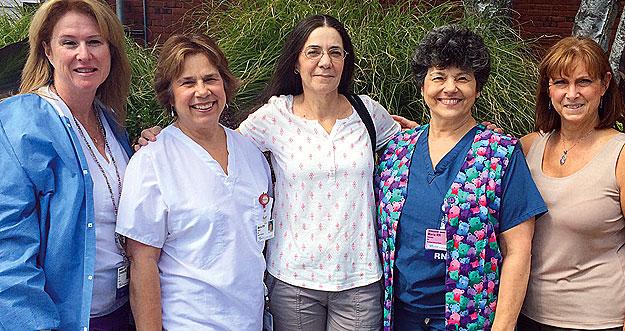Contract Win at Southside Hospital

RNs at Southside Hospital ratified a contract renewal in August, a crowning achievement for the 10-nurse bargaining committee after 16 negotiating sessions conducted over several months. Southside, a 341-bed hospital located in Bay Shore, Long Island, is part of the North Shore-LIJ network.
The contract includes significant economic and nursing practice gains and zero givebacks. The unit’s 750 nurses won 3 percent annual across-the-board wage increases as well as improvements in step increases, charge pay, and uniform allowances — a combined increase of nearly 12% over the three-year term. To improve patient safety the hospital agreed to fund a new 30-FTE float pool to address staffing shortages. In addition, nurses will see increased member release time, more funding for staff development, and additional work scheduling posting time.
Well-prepared bargaining
Southside nurses also won an outstanding early retirement package, retro pay, and improvements in vacation — not easily obtained in today’s bargaining climate. “We had to maneuver through the minefield of early retirement benefits and came out with a more than satisfactory solution,” said committee member Marie Boyle, RN. Fellow committee member and Southside Grievance Chair Linda Joyce, RN, added, “We got retro pay that hasn’t been won in years.”
The bargaining committee began preparations more than three months prior to the February 2015 expiration by surveying members on contract priorities and formulating initial demands. They then strategized with NYSNA negotiating staff to fine-tune proposals and commence bargaining as a unified, well-prepared team.
While there was plenty of debate away from the table, the committee maintained a single voice with the employer that paid off in the end with a great contract. “When it was just the committee, we debated but respected everyone’s opinion. We all had an equal voice,” said Marianne Walsh, RN and Southside’s LBU President. “There were no factions, our opinions differed on some issues, but in the end we all looked at what was the best for the entire membership, not just a select few.”
Member-driven process
For the first time, Southside’s own committee members sat across from management and did the talking at the table, and, as a result, the hospital’s management got a better understanding of the saliency of the issues. The bargaining committee agreed that the new framework, in which the members drive the process, made for a more productive and professional bargaining experience than in the past.
A clear message
“The fact that we each had the opportunity to speak to management directly was important,” said committee member Maria Harmel, RN. “At previous negotiations, we never said a word. It was purely a business meeting between opposing sides. This time, with our active participation, I think it was frequently humbling for management to hear about how our on-the-job, real-life experiences informed our rationale for certain demands. It enabled them to identify with us as ‘living and breathing nurses’ who are the life lines at the hospital, rather than see our union as a third party.”
Ms. Joyce credits the nurses’ success to the fact that “the committee was cohesive and respectful.” Her colleague, Ms. Boyle, said, “We kept our message clear: if you want good, competent professionals, you must compensate accordingly. If you want your patients to be safe, you must have a trained, professional staff with safe patient-to-nurse ratios. They seemed to listen.”
In the end, members left the bargaining table empowered and highly satisfied with the results. “This has been one of the most rewarding negotiations I have ever worked on,” said Ms. Boyle — a widely held sentiment.